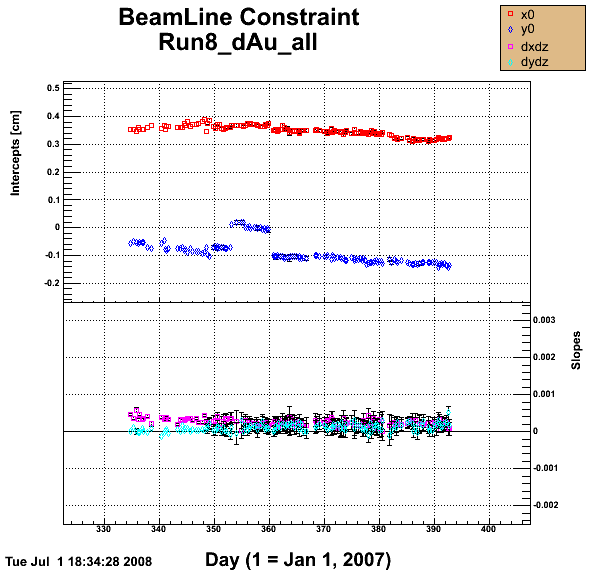Run 8 (200 GeV dAu and pp)
BeamLine for dAu
BeamLine for pp
This calibration work was discussed at two Software & Computing meetings (You do not have access to view this node,You do not have access to view this node). After resolving an issue with reading the triggers in early runs from before day 348 (December 14, 2007), the calibration was completed using the following "oval" cuts (the cut forms something like an oval curve in the mult vs. rank space) on the output ntuple from the StVertexSeedMaker code to avoid pileup vertex contributions:
"((rank+3)*(rank+3)/22.+(mult*mult/4900.))>1&&rank>-3&&zdc<5.5e5"
One additional note is that fill 9307 starting on November 30 looked like it might have some useful data, but I did not successfully get enough data to calibrate it. So I will use the next physics fill (9311) as the calibration for 9307 as well in case that data is used.
The result of the final calibration can be seen in this plot:

The query file to pick out runs is attached below.
The preliminary pp calibration was done using a simple rank and multiplicity cut:
"rank>-1&&zdc<2e5"
with results as seen here:

After studying the data from day 49 (February 18) and after, it did not appear that there were any significant changes to the actual beam tune. The most difficult obstacle was to overcome the significant amounts of pileup in the data, for which the ranking given by the Minuit vertex finder was of little help (as a reminder, PPV (the "pileup-proof vertex finder") does not work without a BeamLine constraint, and so cannot be used to calibrate the BeamLine).
Additional confusion resulted from whether trigger selections could be made which were truly helpful. For example, a minbias vertex should represent the least amount of biasing in vertex selections, but high-tower triggered events will have better discrimination power against pileup vertices. Because my studies showed that pileup tended to bring the value of x0 lower, and high-tower triggered events always gave a higher x0 than minbias or fmsslow events, I decided to go with the high-tower triggers and used a stringent set of cuts on all of the data from day 49 and after to find a single calibration set:
"zdc<2e5&&rank>0&&mult>40&&abs(z)<80&&trig>220400&&trig<220600"
Of further note, the width I attributed to the beam collision zone itself had some bearing on the resulting fit. In the end, I used 400 microns as this intrinsic width. So I believe the calibration for all pp data from February 18 through March 10 as a single set is rather well determined. Larger fluctuations in the operating conditions of the collider occurred in days prior to day 49, so it is not clear that improvements can be made in the calibration of that earlier pp data which would be worth their effort in terms of physics gains.
The final calibration set then appears as follows, with all data from days 49-70 represented by a single calibration set.

The query file to pick out runs is attached below.
G. Van Buren
- Printer-friendly version
- Login or register to post comments
